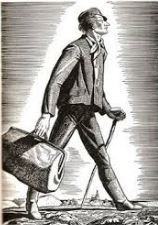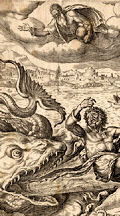Read: Section 1,
Etymology and Extracts and Chapters 1-21
Download This Article

As a first time reader of Moby Dick, skip Etymology and Extracts. It serves as a prologue to the novel and shows the wide influence of whales and the nineteenth century whaling industry. You will read plenty about both in the novel itself. You can return to Etymology and Extracts after finishing the novel.
Begin your reading at Chapter 1 where the story begins.

Your Next Goal: Read: Section 2, Chapters 22-42

Etymology and Extracts and Chapters 1-21
Download This Article

Overview
Free Advice: take it or leave it.
As a first time reader of Moby Dick, skip Etymology and Extracts. It serves as a prologue to the novel and shows the wide influence of whales and the nineteenth century whaling industry. You will read plenty about both in the novel itself. You can return to Etymology and Extracts after finishing the novel.
Begin your reading at Chapter 1 where the story begins.

The Narrator, Ishmael
Ishmael reveals much about himself, beginning with the now famous opening line of Chapter 1. As you read, try to become Ishmael. At the very least, avoid judging him until the journey is over. Join him in learning.- How do you describe Ishmael's tone of voice in the first chapter? Does he sound confident, worried, fearful, boastful, other?
- Specifically, why does he want to ship out?
- What seems to be his philosophy of life as he travels to New Bedford to ship out?
- What does he have to say about the differences between landsmen and seamen?
- What is his attitude toward religion and spirituality? Is there a distinction between them?
- What conclusion(s) has he drawn about the ideals of the Noble Savage and Christianity?
- Does he seem to believe in Free Will, Fate, or a combination of the two, such as Machiavelli supports in the closing chapter of The Prince?
- By the end of Chapter 21, does Ishmael seem to have a particular moral attitude, or is it too early to determine?
- Take special note of the chapters entitled, The Pulpit (ch. 8) and The Sermon (ch. 9). What is the message in Brother Maple's sermon?
Your Next Goal: Read: Section 2, Chapters 22-42

Suggested
Keep reading or pause for these extensions.- Read the Biblical story of Jonah and the Whale.
- Melville fashioned the Chapel of Brother Maple after the Seamen's Bethel, which is still active today in New Bedford. Read about and see pictures of the Seamen's Bethel.
Scroll down to see the inside of the chapel. Compare the actual look of it with Melville's description.